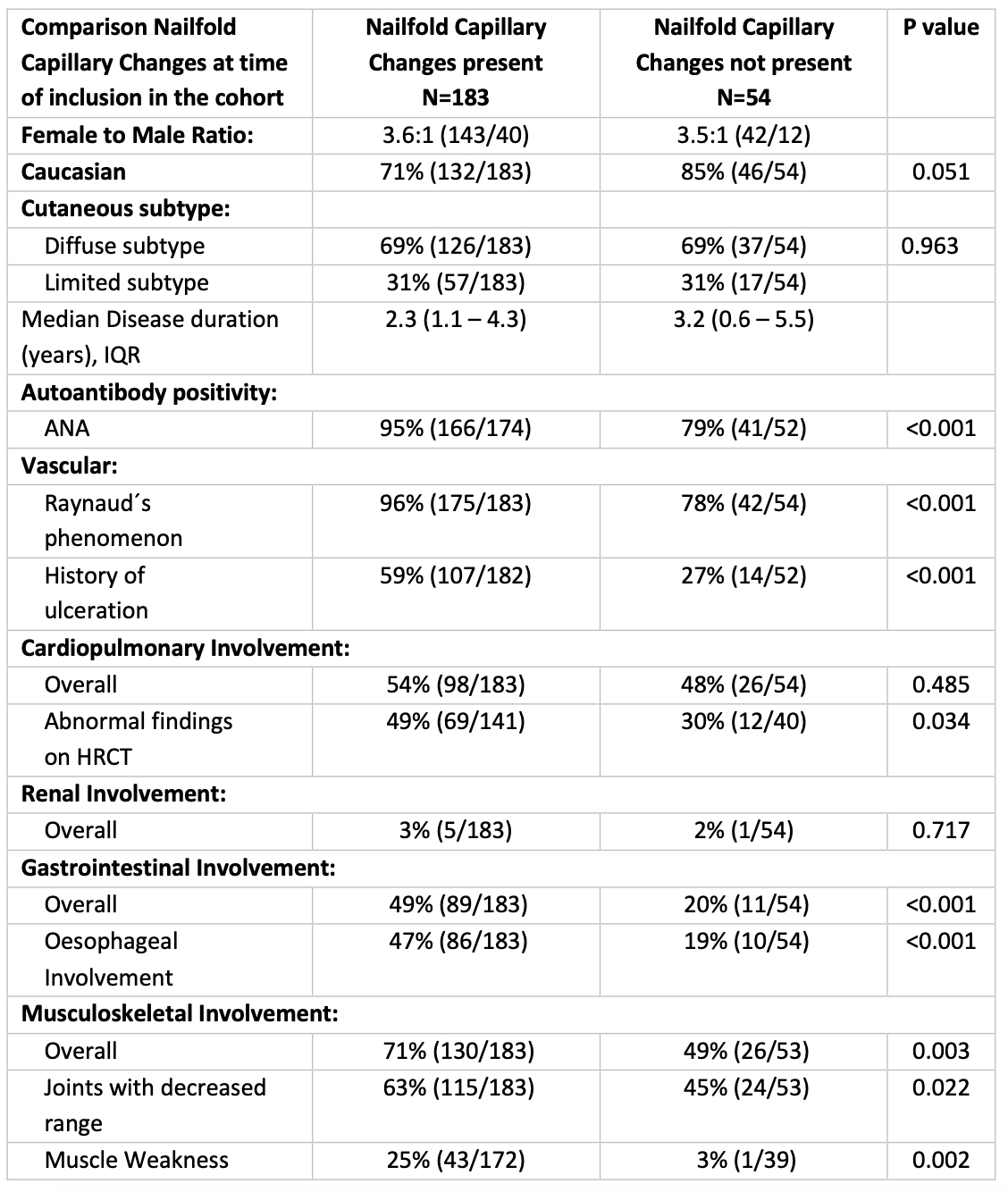Session Information
Session Type: Poster Session C
Session Time: 10:30AM-12:30PM
Background/Purpose: Juvenile systemic scleroderma (jSSc) is an orphan disease with a prevalence in 3 in 1 000 000 children. Positive nailfold capillaroscopy (NF+) finding correlate with more severe disease in adult systemic scleroderma [1]. There is currently no data if this correlation does exist in jSSc.
Methods: Baseline data was extracted from patients enrolled in the juvenile scleroderma inception cohort that had nailfold capillaroscopy performed at inclusion [2] until 1st of December 2023. NF was performed by dermatoscope and/or high resolution video nailfold capillaroscopy. We compared patients with NF+ and NF- findings from the baseline visit using chi-square test.
Results: 237 patients were included in the analysis, 185 (78%) of them were female. 126 (70%) had diffuse subtype. 183/237 patients (77%) were in the NF+ group. 71% in the NF+ group were Caucasian compared to 85% in the NF- group (p=0.051). Median disease duration was 2.3 years in the NF+ and 3.2 years in the NF- patients. Median age at onset of the first non-Raynaud´s was around 11 years in both groups. More patients in the NF+ group were ANA positive (95% compared to 79%, p< 0.001). There was no difference in the anti-Scl70 or anti-centromere distribution.
NF+ patients had significantly more frequent Raynaud phenomenon (96% compared to 78%, p< 0.001); history of digital ulcerations (59% compared to 27%, p< 0.001); abnormal high resolution CT findings of the lung (49% compared to 30%, p=0.034); overall gastrointestinal involvement (49% compared to 20%, p< 0.001); oesophageal involvement (47% compared to 19%, p< 0.001); musculoskeletal involvement (71% compared to 41%, p=0.003); presence of joints with decreased range (63% versus 45%, p=0.022) and presence of muscle weakness (25% compared to 3%, p=0.002). No significant differences were demonstrated in involvement of other organ systems such as skin, cardiac or renal. (see table 1)
Conclusion: In a jSSc cohort there were significantly more patients affected within various organ systems in those with nailfold capillary changes at enrollment compared to those without. Future studies should assess whether these differences persist over time.
[1] Vanhaecke A, Cutolo M, Distler O, et al. Nailfold capillaroscopy in SSc: innocent bystander or promising biomarker for novel severe organ involvement/progression? Rheumatology (Oxford). 2022 Nov 2;61(11):4384-4396.
[2] Foeldvari I, Klotsche J, Kasapcopur O, et al. Differences Sustained Between Diffuse and Limited Forms of Juvenile Systemic Sclerosis in an Expanded International Cohort. Arthritis Care Res (Hoboken). 2022 Oct;74(10):1575-1584.
To cite this abstract in AMA style:
Foeldvari I, Klotsche J, Torok K, Kasapcopur O, Adrovic A, Feldman B, Anton J, Johnson S, Sztajnbok F, Terreri M, Sakamoto A, Stanevica V, Schonenberg-Meinema D, Alexeeva E, Katsicas M, Khubchandani R, Sawhney S, smith v, Al-Abadi E, Appenzeller S, Avcin T, Kostik M, Lehman T, Malcova H, marrani e, Pain C, Patwardhan A, Sifuentes-Giraldo W, Vasquez-Canizares N, Abu Alsaoud S, Costa Reis P, Janarthanan M, Nemcova D, Santos M, Helmus N. Presence of Nailfold Capillary Changes Correlates with More Severe Organ Involvement in Juvenile Systemic Scleroderma. Results of the Juvenile Scleroderma Inception Cohort [abstract]. Arthritis Rheumatol. 2024; 76 (suppl 9). https://acrabstracts.org/abstract/presence-of-nailfold-capillary-changes-correlates-with-more-severe-organ-involvement-in-juvenile-systemic-scleroderma-results-of-the-juvenile-scleroderma-inception-cohort/. Accessed .« Back to ACR Convergence 2024
ACR Meeting Abstracts - https://acrabstracts.org/abstract/presence-of-nailfold-capillary-changes-correlates-with-more-severe-organ-involvement-in-juvenile-systemic-scleroderma-results-of-the-juvenile-scleroderma-inception-cohort/

